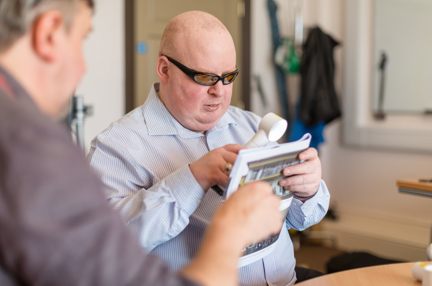Home adaptations for low vision
Simple adaptations around the home can make all the difference for someone with sight loss, and there are lots of low-cost strategies that can help.
We’ve found that what works for one person may hinder another, so we’ve collated some of the most common techniques used by our veterans for you to consider.

Invest in good lighting
For someone with low vision, investing in good, controlled lighting can be key.
Focus on reducing glare and keeping a good balanced lighting environment.
Task lamps can make all the difference and dimmer switches can make you more comfortable.
It may sound obvious, but keeping the lights on during the day is fine if it benefits your sight.
Use contrasting colours
- Using contrasting colours to make things stand out from their background is another technique you can use to see objects more clearly, even if you can’t pick out the detail.
- For example, try using a blue chopping board over a white one when slicing onions, or a white strip painted on the lip of a step. It really can make a huge difference.
Change the size
Large print correspondence should be available for all your bills and statements and you might also benefit from a bigger TV or computer monitor, or simply sitting closer to the one you have.
On the other hand, if you have peripheral sight loss, otherwise known as tunnel vision, you may need things to be smaller to fit in the small window of your functional vision. Do whatever works for you.
Organise yourself
- As the saying goes, “A place for everything and everything in its place,” and this is never more relevant when you have sight loss. Put simply, if you can’t see well enough to search for an item then you need to know exactly where to find it.
- Family, friends and carers take note and always check with someone with a sight loss before you move their things around. Even if it looks wrong to you, anything from their furniture and rugs to larger items may be landmarks to aid their orientation.
Consider smart home technology
Smart home technology enables you to control home appliances such as lighting or heating through your smartphone or computer. It’s now widely available and can be a big help for people with sight loss.
With solutions like Amazon Alexa or Google Home you can use this technology simply by using your voice. For example, once programmed, you could turn on the heating simply by saying, “Alexa, turn the heating on.”
You can also set reminders, store shopping lists and access useful information through this technology, such as local bus times – all by using your voice.
Also, many modern TVs and smartphones will have built-in ‘accessibility’ options such as large or high contrast print and spoken feedback. Read our guide on Watching TV with Low Vision.
"There are so many strategies and pieces of equipment that can help you around the home. The most important thing is to try different approaches to see what works best for you."
Other tips and tricks
Individualise items
Clothes pegs and elastic bands can be attached to items to individualise them. For example, try putting a band around the shampoo bottle so it doesn’t get mixed up with the shower gel.
Carry a thick pen
Keep a thick pen and lots of scrap paper for making large notes or lists.
Use blue tac
Blue tac can be used to mark specific controls, such as the temperature on a thermostat or a particular button on the remote.
Buy accessible gadgets
It’s always worth looking at options for more accessible gadgets like large-key keyboards or a larger remote control for your TV as these can really help.
Use a tray
Set everything you need for a task on a tray as this will help catch spillages or small items, and generally help keep the items you need together.
Use a bowl for meds
Try using a bowl to press tablets into so they don’t escape onto the floor. (Read our guide, Getting Ready for the Day for tips on washing, dressing and taking medication.)
Make use of all adaptations
And, finally, don’t forget to use the adaptations already in place. For example, the bump on the number 5 on your phone and TV remote is there to use as a point of reference.
Get personalised guidance
If you’re a beneficiary of Blind Veterans UK, please contact your local community team for personalised guidance on home adaptations.
Read more
Safeguarding: Keeping people with sight loss safe from abuse
14 Nov 2023
The most common forms of abuse and what to look out for.

Sight loss aids for reading printed text
10 Dec 2023
Aids for people who are blind or partially sighted to help with reading letters, books and other printed materials.

Seeing text more clearly on a screen
19 Oct 2023
Enhancing your screen reading experience across different devices, from computers to mobile phones.
